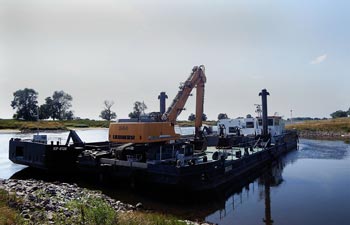If you have a private waterbody on your property or are responsible for the maintenance of a waterway, chances are you’ll need to hire a professional dredging contractor at some point. is an essential component of waterway maintenance that can help combat the effects of erosion and keep your waterbodies healthy. Read on to learn what dredging is and how it can benefit you.
What Is Dredging?
Dredging is the process of scooping out silt, sediment, weeds, or other materials from the bottom of a waterbody. This is usually done when sediment shifts in such a way that boats can no longer safely pass through a body of water, but can also be done to maintain lakes, rivers, or private ponds by removing trash or other debris that are clogging the waterway and preventing habitat growth.
Dredging requires specialized equipment. A suction dredger works like a vacuum to suck up material, while a mechanical dredger looks and functions much like an excavating machine. There are other types of dredgers, such as ones designed to grab material rather than scoop, but these are the two that dredging contractors most often use.
Types of Dredging
There are two main types of dredging: hydraulic and mechanical. Hydraulic dredging involves a dredging machine that uses suction to remove sediment from the bottom of a waterbody. This sediment travels through a pipeline to the dumping site. The main drawback to hydraulic dredging is that there is a limit to the size of material the machines can handle, making it a better choice for projects in which small, fine materials are being removed.
Mechanical dredging, on the other hand, is a much simpler process. Dredging equipment is loaded onto a barge that floats on the surface of the water. The machines then dig sediment from the bottom of the pond, scooping it into the bucket of the machine and depositing it on the barge temporarily until it can be unloaded and removed to a dumping site.
In either case, you must have a permit-authorized dumping site available to deposit the debris. This area should be enclosed by an erosion fence and must be authorized by the U.S. Army Corps of Engineers before you can proceed with your dredging project. It’s important that dredging your waterbody won’t harm the environment in any way, either by disturbing toxins in the water or introducing them to your dumping site.
The type of dredging you decide to use ultimately depends on your budget and the nature of your dredging project. Mechanical dredging is a better choice for projects that involve dredging up large rocks or debris, while hydraulic dredging is a bit more precise about the materials the machines can remove. Mechanical dredging tends to be more budget-friendly than hydraulic dredging and can be done in smaller ponds and waterbodies.
At McCullough Excavating, our Bainbridge, IN dredging contractors are renowned as one of the nation’s leaders in mechanical dredging. Our team has years of experience in dredging ponds, lakes, streams, and other waterways. For your next dredging project, give us a call at (765) 386-6514.

